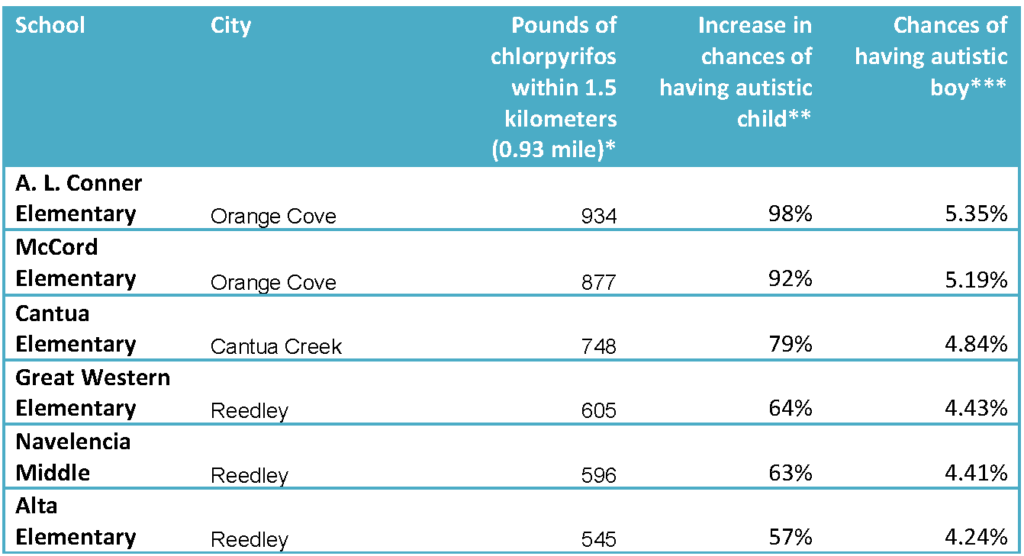
By Nayamin Martinez and Robbie Edwards
We shouldn’t even be discussing the dangers of brain-harming chlorpyrifos, but the Trump administration has twice stopped it from being banned in the United States. The first time was when the Trump administration refused to accept the recommendation of its own Environmental Protection Agency (EPA) scientists to stop chlorpyrifos use in the fields in March 2017. Then, the 9th U.S. Circuit Court of Appeals ordered the Trump administration to take chlorpyrifos off the shelves last August, but Trump’s people appealed it.
Despite what is going on at the federal level, our state authorities can and should protect us. The California Department of Pesticide Regulation (DPR) must act today by suspending chlorpyrifos registrations. Abiding by the Food and Agriculture Code, the DPR has the power because there are multiple reasons to believe that the use of chlorpyrifos “constitutes an immediate substantial danger to persons or to the environment” (Food & Agriculture Code § 12826).
The threat of this dangerous pesticide is more significant for some parts of our state than others, including Fresno County, which ranks second in the list of counties where chlorpyrifos is used the most in agriculture. The science suggests Fresno babies’ brains are being damaged by each day of continued chlorpyrifos use.
The UC Davis CHARGE Study (2014) found that for every 100 pounds of chlorpyrifos applied within one mile of a pregnant woman, her child’s chances of having autism spectrum disorder (ASD) increase by 14%. That means 200 pounds would increase chances by 28%; 300 pounds by 42%, etc. Over the course of a 9-month pregnancy, the average monthly nearby application is only 11 pounds, correlating with a 14% increase in the likelihood of having a child with ASD.
Employing similar methods for estimating chlorpyrifos use as the CHARGE researchers, we found six schools in Fresno County that had more than 545 pounds of chlorpyrifos within one mile in 2016. That would mean a minimum 57% increase in the odds of having a child with autism, according to the correlations found in the UC Davis study. At A.L. Connor and McCord elementary schools in Orange Cove, the chances are nearly doubled, 98% and 92%, respectively. In other words, instead of the average 1 in 37 chance of having an autistic boy, the odds grow to 1 in 19 if the mother lived near these schools during her pregnancy.
Chlorpyrifos Used in Fresno County/Prenatal Proximity and Increased Autism in Children, 2016 (more than 500 pounds within 1 mile)

*DPR Pesticide Use Reports downloaded from CalPIP. GIS mapping used at 1.5-kilometer radius from school center. Proportion of the Public Land Survey (PLS) squares covered by the 1.5-kilometer radius circle (with corresponding proportion of poundage) added together to estimate pounds applied.
**Using formula: Chlorpyrifos pounds/133 pounds * (14% increase in ASD chances). Annual figure adjusted to correspond to average monthly applications during nine-month pregnancy: (100 pounds/9 months) * 12 months = 133 pounds.
***Based on recent data indicating that autism affects 1 in 37 boys or 2.7%.
A UC Berkeley CHAMACOS Study (2017) found that for every 522 pounds of combined organophosphate pesticides, including chlorpyrifos, applied within 1 kilometer (0.62 mile) of a pregnant woman, her child tended to lose more than 2 IQ points. Six Fresno County schools had between 419 and 652 pounds applied in 2016 within 1 kilometer, which could indicate an IQ loss of between 1.3 and 2.1 points, had the pregnant mother lived near these schools. See the table below for the alarming details.
Organophosphates (OP) in Fresno County/Prenatal Proximity and IQ Loss, 2016 (above 400 pounds within 1 kilometer)

*DPR Pesticide Use Reports downloaded from CalPIP. GIS mapping used at 1-kilometer radius from the school center. Proportion of the PLS squares covered by the 1-kilometer radius circle (with corresponding proportion of poundage) added together to estimate pounds applied.
**Using formula: OP total pounds/696 pounds * (-2.2 IQ points). Annual figure adjusted to correspond to average monthly applications during 9-month pregnancy: (522 pounds/9 months) * 12 months = 696 pounds.
Our community is asking the same question about chlorpyrifos posed by Kim Harley, a CHAMACOS researcher: “At a certain point, you have to say, ‘How much proof do we need before we act?’” (Sierra, September/October 2018). We demand that DPR suspend chlorpyrifos now!
*****
Nayamin Martinez is the executive director of the Central California Environmental Justice Network. Robbie Edwards is a research intern with Californians for Pesticide Reform.
